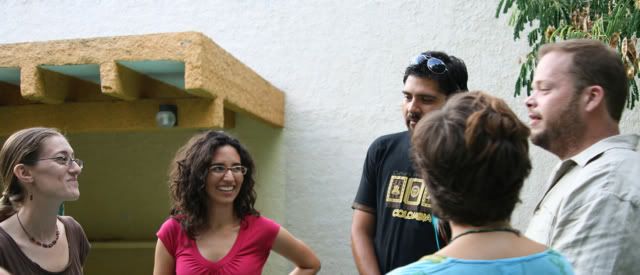 Last year we were sitting in a staff meeting at our school Habla discussing how we might better induct new teachers into the culture of the school. This quickly led to the question, "What exactly is the culture of Habla? How would we put it into words?" Over the years I've seen how policy makers and education leaders think they might create a shared culture by developing lists of standards or principles or by publishing documents that they think will influence teachers' practices in the classroom. Many of these well-meaning attempts burden teachers with a labyrinth of documents that seem to have little application to the classroom. However, in some cases when these frameworks are straightforward--like Ted Sizer's essential school principles, Debbie Meier's Habits of Mind, Howard Gardner's multiple intelligences, or the ArtsLiteracy Project's Performance Cycle--they can be useful. They can help us define our practices as teachers or give a sense of what a school culture might look like.
Last year we were sitting in a staff meeting at our school Habla discussing how we might better induct new teachers into the culture of the school. This quickly led to the question, "What exactly is the culture of Habla? How would we put it into words?" Over the years I've seen how policy makers and education leaders think they might create a shared culture by developing lists of standards or principles or by publishing documents that they think will influence teachers' practices in the classroom. Many of these well-meaning attempts burden teachers with a labyrinth of documents that seem to have little application to the classroom. However, in some cases when these frameworks are straightforward--like Ted Sizer's essential school principles, Debbie Meier's Habits of Mind, Howard Gardner's multiple intelligences, or the ArtsLiteracy Project's Performance Cycle--they can be useful. They can help us define our practices as teachers or give a sense of what a school culture might look like.
In our staff meeting we discussed the possibility of retreating to our computers and writing our version of "The Habla Core Values" or some similar document. We decided to try a different approach. We had a faculty meeting coming up soon with our teachers, and we thought it a much better idea to seek the wisdom of the group, to ask them to find the words to describe what teaching and learning looks like at our school. We were stunned by our teachers' responses. Habla is just over two years old. Three of the teachers out of twelve had only been at Habla for two weeks and most had worked at Habla less than a year. Here is their unedited list:
I was recently impressed again by the creative work of our teachers. At the beginning of the year each teacher in our school, with the help of Arnold Aprill at CAPE, developed research questions about their own practices. Throughout the year we met, discussed their questions, and the teachers collected evidence in the form of videos, photographs, student work, and ethnographic documentation that demonstrated their thinking around their questions. Last week all of our teachers presented in the form of a PechaKucha, where they showed 20 images and discussed each one for 20 seconds. Again, the culture that we hoped to build when we opened Habla was clearly present through all of the presentations as teachers discussed arts-integration, dialogic education, documenting student work, authentic classroom experiences, meaning-making, and building links between the worlds of the students and the classroom.
After two years, the shared sense of culture that we hoped to create among all our teachers at Habla had been realized, but we reached it not through the methods that I see most schools currently employing. My next post will begin to investigate how it is possible to create a culture in a school in ways that value the creativity and intelligence of the teachers.
